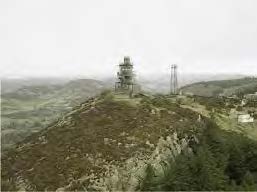
The watchtowers on the hilltops of South Armagh, on the border between the north
and south of were observation posts mounted with powerful camera technologies.
British soldiers, stationed below the towers in luxury trenches, portacabins sunk
into the ground and covered with steel and concrete and recovered with topsoil,
occupied the viewing platforms in pairs and in two-hour shifts. One would observe
while the other documented. It has been said that they could read the speedometer
dials of cars driving below, distinguish patterns on the wallpaper inside houses, see
what was eaten for breakfast and hear what was said over the breakfast table.




The lines of sight from the watchtowers generated a kind of virtual environment
enveloping the border region of Northern Ireland. These high-tech towers,
constructed in the mid 1980s, primarily in the mountainous border region of South
Armagh, were landmarks in the thirty-year conflict in and over Northern Ireland. The
towers were finally demolished between 2003 and 2007 as part of the British
government’s demilitarization programme for Northern Ireland. For a period of over
a year, Donovan Wylie photographed the borderland watchtowers. Working entirely
from an elevated position enabled by military helicopter he created a systematic
survey of the towers, their positions and perspectives with in the landscape
Biography:
Donovan Wylie is an artist and Professor at Ulster University. Belfast. His work chronicles
what he calls “the concept of vision as power in the architecture of contemporary conflict” –
prison, army watchtowers and outposts, and listening stations – “merging documentary and
art photography”. His work has been exhibited in solo exhibitions at the Imperial War
Museum and The Photographers’ Gallery in London, National Media Museum in Bradford,
and Royal Ontario Museum in Toronto; and is held in the collections of the Centre Georges
Pompidou in Paris, Metropolitan Museum of Art in New York, Milwaukee Art Museum,
National Gallery of Canada in Ottawa, Science Museum Group in the UK, Ulster Museum in
Belfast, and Victoria and Albert Museum in London. In 2010 he was shortlisted for the
Deutsche Börse Photography Prize.

